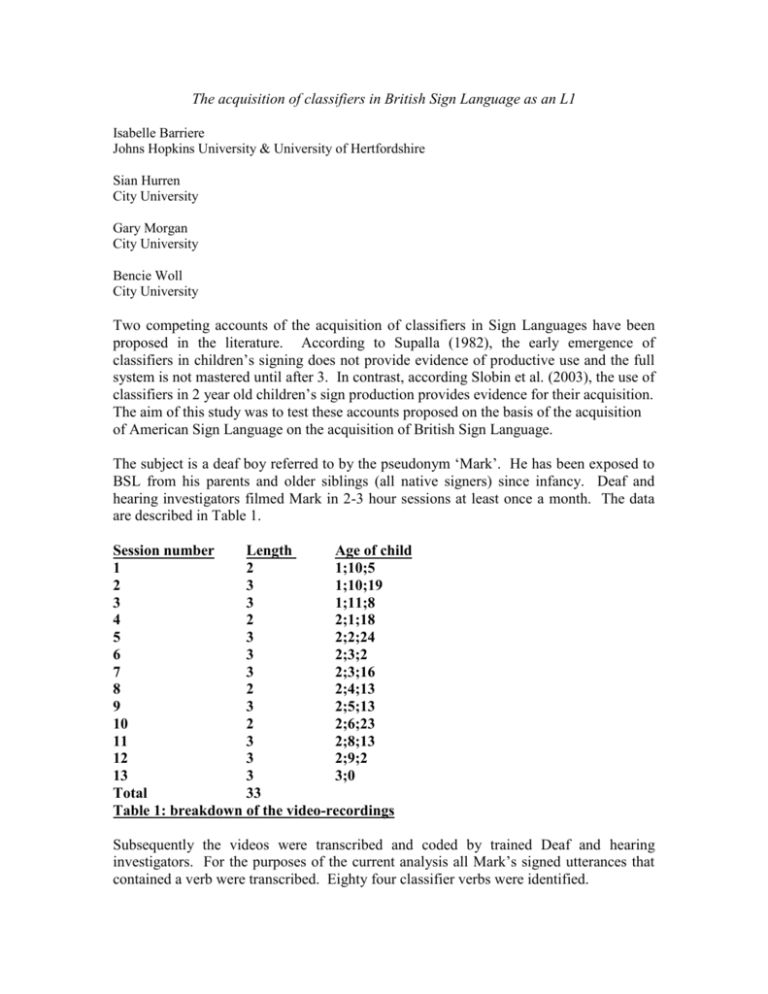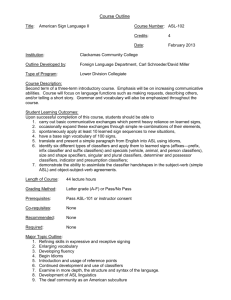The acquisition of classifiers in British Sign Language as an L1
advertisement

The acquisition of classifiers in British Sign Language as an L1 Isabelle Barriere Johns Hopkins University & University of Hertfordshire Sian Hurren City University Gary Morgan City University Bencie Woll City University Two competing accounts of the acquisition of classifiers in Sign Languages have been proposed in the literature. According to Supalla (1982), the early emergence of classifiers in children’s signing does not provide evidence of productive use and the full system is not mastered until after 3. In contrast, according Slobin et al. (2003), the use of classifiers in 2 year old children’s sign production provides evidence for their acquisition. The aim of this study was to test these accounts proposed on the basis of the acquisition of American Sign Language on the acquisition of British Sign Language. The subject is a deaf boy referred to by the pseudonym ‘Mark’. He has been exposed to BSL from his parents and older siblings (all native signers) since infancy. Deaf and hearing investigators filmed Mark in 2-3 hour sessions at least once a month. The data are described in Table 1. Session number Length Age of child 1 2 1;10;5 2 3 1;10;19 3 3 1;11;8 4 2 2;1;18 5 3 2;2;24 6 3 2;3;2 7 3 2;3;16 8 2 2;4;13 9 3 2;5;13 10 2 2;6;23 11 3 2;8;13 12 3 2;9;2 13 3 3;0 Total 33 Table 1: breakdown of the video-recordings Subsequently the videos were transcribed and coded by trained Deaf and hearing investigators. For the purposes of the current analysis all Mark’s signed utterances that contained a verb were transcribed. Eighty four classifier verbs were identified. The linguistic analysis of classifiers by Kegl (2002) was adopted. It demonstrates that verbs that contain classifiers have several layers of sublexical depth and are governed by systematic word formation rules. On the basis of these linguistic considerations, the analyses of classifiers must take into account their distribution within verbs and the modulation of these verbs at the corpus level. In order to assess the productivity of the classifiers systems, the distribution of the verbs, of the class of objects and of the location or movement expressed were examined. Evidence of productivity of handshape (i.e. different handshapes used with the same verbs) referring to distinct classes of objects was found to emerge at 2;6. Evidence for the second criterion of productivity (i.e. the use of the same handshapes with different verbs) was identified from age 2;9. The analysis of unadultlike constructions reveals a contrastive pattern: while only 2% of errors in movement/location were produced by Mark, the inappropriate selection of handshapes constituted 18% of his utterances that contain verb classifiers. Three explanations could explain the latter aspect of Mark’s production of classifiers: I. Lack of mastery of the phonological characteristics of these handshapes; II. Lack of mastery of the semantic mapping between the class of objects and the appropriate handshape; III. The sublexical complexity of classifiers verbs. Bakker (2003) carried out a detailed analysis of Mark’s phonological production and found that the handshapes used in classifier verbs are mastered by Mark who uses them in single signs. This excludes hypothesis I. Furthermore these lexical signs were used appropriately, which excludes hypothesis II. Our analyses of Mark’s verb classifiers production do not support Slobin et al. (2003)’s hypothesis: evidence of productivity of the system is not found at age 2. The consideration of a) the combinations of the handshapes and the verbs, b) the unadultlike patterns that include, as mentioned above, very few errors in location/movement and more errors in handshape referring to classes of objects and c) bare forms not found in the adult language point to a discontinuity between the early emergence of classifiers as unanalyzed forms (between 1;10 and 2) and the late mastery of the principles that govern the combinations of the sublexical elements that compose them.







